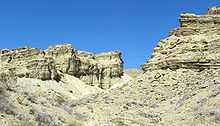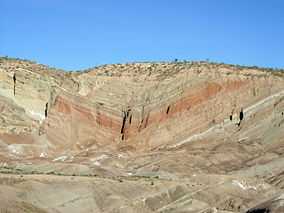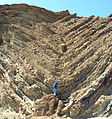Barstow Formation
| Barstow Formation Stratigraphic range: Early to Middle Miocene | |
|---|---|
 Barstow Formation exposed in Owl Canyon near Barstow, California. | |
| Type | Sedimentary |
| Lithology | |
| Primary | limestone, shale, siltstone, sandstone, tuff |
| Other | conglomerate |
| Location | |
| Region | Mojave Desert |
| Country | United States |
| Extent | Southeastern California (San Bernardino County) |
| Type section | |
| Named for | Barstow, California |
| Named by | Hershey (1902) |
The Barstow Formation is a series of limestones, conglomerates, sandstones, siltstones and shales exposed in the Mojave Desert near Barstow, California.[1][2] It is early to middle Miocene (19.3 - 13.4 million years ago) in age,[3] and lends its name to the Barstovian North American land mammal age (NALMA). The sediments are fluvial and lacustrine in origin except for nine layers of rhyolitic tuff.[3] It is well known for its abundant vertebrate fossils including bones, teeth and footprints.[4] The formation is also renowned for the fossiliferous concretions in its upper member, which contain three-dimensionally preserved arthropods.
Fossils
Arthropods
The arthropods in the upper member of the Barstow Formation are preserved in concretions. The concretions are calcareous and range from 0.125 cm3 to 125 cm3. The fossils are typically three-dimensional and, on occasion, exhibit internal anatomy. Due to the preservation of soft-tissue, the Barstow Formation has been identified as a Konservat-Lagerstätte deposit. The fauna was first recognized in 1954 by Allen M. Basset and Allison "Pete" R. Palmer.[5]
The concretions from the Barstow Formation preserve both allochthonous arthropod communities and rare autochthonous arthropod communities. Over 21 orders of arthropods have been recorded. The fossil assemblage is dominated by Diptera (Dasyhelea australis antiqua), Coleoptera (Schistomerus californese), and Anostraca (Archaebranchinecta barstowensis).[6][7][8]
See also
References
- ↑ Dibblee, T.W., Jr. (1967). Areal Geology of the Western Mojave Desert, California. Geological Survey Professional Paper no. 522. United States Government Printing Office, Washington D.C.
- ↑ Dibblee, T.W., Jr. (1968). Geology of the Fremont Peak and Opal Mountain Quadrangles, California. California Division of Mines and Geology, San Francisco.
- ↑ 3.0 3.1 Woodburne, M.O., Tedford, R.H., Swisher III, C.C. (1990). Lithostratigraphy, biostratigraphy, and geochronology of the Barstow Formation, Mojave Desert, southern California: Geological Society of America Bulletin, Vol. 102, p. 459-477.
- ↑ Lindsay, E.H. (1972). Small Mammal Fossils from the Barstow Formation, California. University of California Publications in Geological Sciences, Vol. 93. University of California Press, Berkeley.
- ↑ Palmer, A.R., Basset, A.M. (1954). Nonmarine Miocene arthropods from California. Science, Vol. 102, p.228-229
- ↑ Lisa E. Park & Kevin F. Downing (2001). "Paleoecology of an exceptionally preserved arthropod fauna from lake deposits of the Miocene Barstow Formation, Southern California, U.S.A". Palaios 16 (2): 175–184. doi:10.1669/0883-1351(2001)016<0175:POAEPA>2.0.CO;2.
- ↑ Denton Belk & Frederick R. Schram (2001). "A new species of anostracan from the Miocene of California". Journal of Crustacean Biology 21 (1): 49–55. doi:10.1651/0278-0372(2001)021[0049:ANSOAF]2.0.CO;2. JSTOR 1549760.
- ↑ D. Christopher Rogers & Jorge S. Coronel (2011). "A redescription of Branchinecta pollicifera Harding, 1940, and its placement in a new genus (Branchiopoda: Anostraca: Branchinectidae)". Journal of Crustacean Biology 31 (4): 717–724. doi:10.1651/10-3449.1.
-
Syncline in the Barstow Formation exposed in Rainbow Basin near Barstow, California.
-
Syncline in the Barstow Formation, lower parking lot of Calico Ghost Town near Barstow, California.
-

Anticline in the Barstow Formation (Miocene) at Calico Ghost Town near Barstow, California.
-

Cameloid footprint (Lamaichnum alfi Sarjeant and Reynolds, 1999; convex hyporelief) from the Barstow Formation of Rainbow Basin, California.

